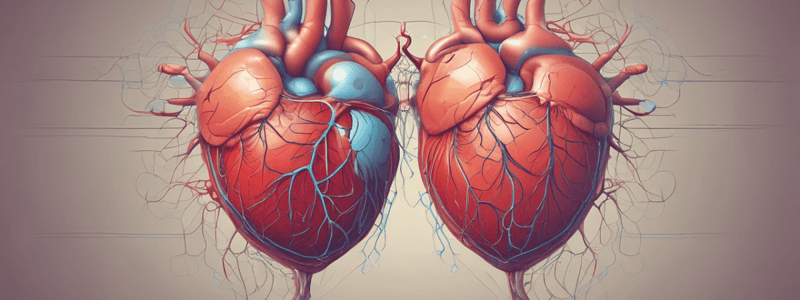Podcast
Questions and Answers
What is the unit of measurement for stroke volume?
What is the unit of measurement for stroke volume?
- %
- beats/min
- mL (correct)
- mL/min
Which of the following is NOT a factor that affects cardiac output?
Which of the following is NOT a factor that affects cardiac output?
- Body metabolism
- End-diastolic volume (correct)
- Size of the body
- Exercise
What is ejection fraction a measure of?
What is ejection fraction a measure of?
- The effectiveness of the ventricles in ejecting blood (correct)
- The total volume of blood ejected by the left ventricle per unit time
- The number of beats per minute
- The volume of blood ejected out of the left ventricle during each systolic cardiac contraction
What is the formula to calculate cardiac output?
What is the formula to calculate cardiac output?
What happens to ejection fraction when contractility increases?
What happens to ejection fraction when contractility increases?
What is the normal value of ejection fraction?
What is the normal value of ejection fraction?
How can cardiac output be increased?
How can cardiac output be increased?
What is the difference between end-diastolic volume and end-systolic volume?
What is the difference between end-diastolic volume and end-systolic volume?
The function of the ventricles can be described by 3 parameters. These are:
The function of the ventricles can be described by 3 parameters. These are:
End Diastolic volume is described as:
End Diastolic volume is described as:
End Systolic volume can be described as:
End Systolic volume can be described as:
The ejection fraction is an indicator of contractility
The ejection fraction is an indicator of contractility
What is cardiac output?
What is cardiac output?
Which of the following can increase stroke volume?
Which of the following can increase stroke volume?
What is the effect of increased contractility on stroke volume?
What is the effect of increased contractility on stroke volume?
Which of the following is NOT a factor that affects stroke volume?
Which of the following is NOT a factor that affects stroke volume?
If end-diastolic volume is increased, what will happen to stroke volume?
If end-diastolic volume is increased, what will happen to stroke volume?
What is the relationship between end-diastolic volume and stroke volume?
What is the relationship between end-diastolic volume and stroke volume?
What determines the resting length from which the cardiac muscle contracts?
What determines the resting length from which the cardiac muscle contracts?
Preload is mainly determined by:
Preload is mainly determined by:
What is the benefit of determining preload in cardiac function?
What is the benefit of determining preload in cardiac function?
Which of the following best describes preload?
Which of the following best describes preload?
Why is it important to understand preload in cardiac function?
Why is it important to understand preload in cardiac function?
Flashcards are hidden until you start studying
Study Notes
Ventricular Function
- Ventricular function is described by three key parameters: stroke volume, ejection fraction, and cardiac output.
Stroke Volume
- Stroke volume is the volume of blood (in mL) ejected out of the left ventricle during each systolic cardiac contraction.
- It is the difference between end-diastolic volume (volume of blood in the ventricle before ejection) and end-systolic volume (volume of blood remaining in the ventricle after ejection).
Ejection Fraction
- Ejection fraction is the fraction (%) of the end-diastolic volume that is ejected in one stroke volume.
- It describes the effectiveness of the ventricles in ejecting blood.
- Normal ejection fraction is around 60% (0.6).
- An increase in ejection fraction reflects an increase in contractility.
- A decrease in ejection fraction reflects a decrease in contractility.
Cardiac Output
- Cardiac output is the total volume of blood ejected by the left ventricle per unit time (in mL/min).
- It depends on stroke volume and heart rate.
- Cardiac output (mL/min) = stroke volume (mL) x heart rate (beats/min).
- Cardiac output varies widely with body metabolism, exercise, age, and body size.
- Cardiac output can only be increased if stroke volume increases, heart rate increases, or both increase.
Factors Affecting Stroke Volume
- Stroke volume can only be increased by either increasing end-diastolic volume or decreasing end-systolic volume
- Three primary factors affect stroke volume:
- Preload: influences stroke volume by modifying end-diastolic volume
- Contractility: affects stroke volume by altering the heart's ability to contract and pump blood
- Afterload: impacts stroke volume by affecting the resistance against which the heart pumps blood
Preload in the Heart
- Preload is the pressure acting to stretch left ventricular (LV) fibers at end-diastole.
- It involves the stretching of cardiac myocytes before contraction, which determines the resting length from which the muscle contracts.
- Preload can be expressed in terms of LV end-diastolic pressure or end-diastolic volume.
- The two main determinants of preload are:
- Diastolic filling
- Venous return
Studying That Suits You
Use AI to generate personalized quizzes and flashcards to suit your learning preferences.



